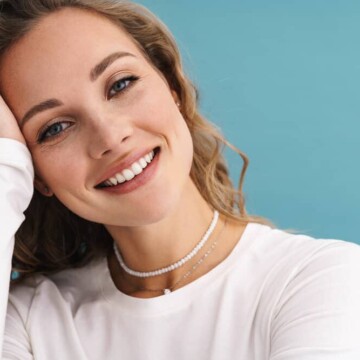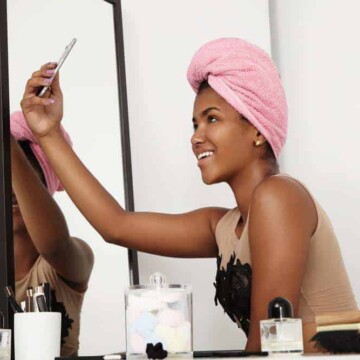
Please make no mistake about it; hair relaxers can be incredibly damaging to your natural hair.
The purpose of this article is to teach you how to relax naturally curly hair without significant damage.
It's important to note that we don't encourage ladies to relax their hair; we're proponents of women wearing their natural hair.
Although, we're more interested in ensuring that ladies are happy with their hair.
Now that we've explained the purpose of this article, if you decide to relax your hair, this article will help ensure that you take the necessary precautions to achieve the best possible outcome for you.
One of the very best things that you can do to mitigate relaxer damage and improve the long-term health of your hair is to prepare it for a chemical relaxer treatment.
The following before and after relaxer strategies are useful regardless if you go to a professional stylist or use a DIY hair relaxer at home.
If you ensure that your hair is in the best possible physical condition before you relax your hair, you will achieve better results from the finished product.
Table of Contents
- 1 How to Relax Curly Hair Without Significant Damage
- 2 What Are the Two Most Common Types of Chemical Hair Relaxers?
- 3 How Do Lye and No-Lye Relaxer Formulas Differ in Terms of Their Chemical Makeup?
- 4 A Closer Look at No-Lye Relaxers
- 5 The Advantages of No-Lye Relaxers
- 6 The Disadvantages of No-Lye Relaxers
- 7 The Best Way to Use No-Lye Relaxers
- 8 A Closer Look at Lye Relaxers
- 9 The Advantages of Lye Relaxers
- 10 The Disadvantages of Lye Relaxers
- 11 Essential Tips for Using Hair Relaxers
- 12 Lye Versus No-Lye Relaxers
- 13 What We've Learned About Relaxing Naturally Curly Hair
- 14 Creamy Crack: Why You Shouldn't Relax Your Hair
- 15 What Happens When You Are Addicted to Creamy Crack?
How to Relax Curly Hair Without Significant Damage
Step 1: Clean Your Hair
You should wash your hair approximately 3 to 5 days before relaxing your hair. With this wash (especially if you want a more thoroughly processed, straighter result from your relaxer), a clarifying shampoo should be used to remove any product buildup or mineral deposits on your hair.
A clarifying shampoo will be powerful enough to remove any product buildup, resulting in a clean head of hair.
For clarifying purposes, we've always liked Pantene's Pro-V Purity Shampoo. Although, I think it's discontinued (or at least hard to find). Click here for our latest recommendations.
If you prefer to have some texture remaining after the relaxer, meaning that you're not trying to achieve a "bone straight" look, then you can continue using your ordinary styling products until you have the relaxer done.
Step 2: Strengthen Your Hair
Before you relax your hair, you should use a protein treatment. We recommend using a moisturizing deep conditioning treatment to follow up the protein treatment.
When your hair is given a protein treatment a few days before your relaxer, the protein treatment will "strengthen" your hair (i.e., provide more protein) in preparation for the relaxer.
That will prevent the relaxing process from completely compromising your hair's strength while the inner protein bonds are being changed during the relaxing process.
To determine which protein reconstructor strength you should use on your hair, first conduct a breakage assessment of your hair. If you have some breakage already then go with a medium to strong protein treatment designed for damaged hair.
If you need a stronger protein conditioner, Aphogee Treatment for Damaged Hair is what we recommend. A milder treatment should work fine if you don't have noticeable breakage.
If you need a milder protein conditioning, I recommend Motions CPR Conditioner or Aphogee 2 Minute Keratin Reconstructor. These products are inexpensive and can be purchased at most beauty supply stores.
You can substitute whichever brand of protein conditioner/reconstructor that you want to use. Following the protein treatment, if you're still experiencing noticeable shedding or breakage, we do not recommend relaxing your hair.
After completing the first two steps, do not scratch, wash, or do anything that will disturb your scalp.
Step 3: Protect Your Hair!
On the day of your relaxer, make sure that you pay close attention to the ends and length of your hair. The ends of your hair are particularly vulnerable to becoming damaged during the relaxing process unless they are protected.
We recommend that you apply a light coating of vaseline, grease, a thick conditioner, castor oil, or olive oil to your scalp, and to your existing relaxed hair (if applicable).
The light coating will help prevent your existing hair from getting "re-relaxed" and potentially further damaging your hair.
We believe that this step is essential to protecting the length of your hair and the ends, as there is usually very little new hair growth being relaxed during "touch-ups". These concepts are often referred to as protective styling in the natural hair community.
One of the numerous reasons why so many women have increasingly thinner hair is due to the chemicals in the relaxer interacting with their existing relaxed hair and failing to protect the ends and shaft of their hair during touch-ups.
Also, keep in mind that oiling your new growth might leave you underprocessed since the relaxer will need to penetrate through all of the layers that you have added.
For a straighter look, make sure your new growth is not coated, only coat the parts of your hair shaft past any new growth. Plus you'll need to protect your scalp.
As always, make sure you apply a protective base, like grease, oil or vaseline, to the tops of your ears, scalp, and any other sensitive areas. This base will provide an extra protective layer between those areas and the relaxer creme.
Step 4: Strand Test Your Hair!
Before a relaxer is applied to your hair, first do a strand test, even if you have used chemical relaxers in the past. Our bodies change continuously, and our allergies and tolerances for certain products also change.
A chemical that might have worked well for you in the past, might suddenly fail to provide you with the desired effect that it did in the past. You will always know where you stand when you perform a strand test.
What Are the Two Most Common Types of Chemical Hair Relaxers?

The pH of most hair relaxers typically falls somewhere between 10 and 14. As the pH level goes up, the amount of swelling and lifting experienced by the hair cuticle also increases.
This increase in swelling usually results in more damage to the hair. Relaxers fall into several different categories ranging from sensitive-scalp formulas to stronger relaxers that are formulated for maximum results.
Typically, the pH level increases along with the strength of the formula, meaning that sensitive formulas usually have the lowest pH and the strongest formulas have the highest pH.
Because they have higher pH values, stronger relaxers tend to cause a greater degree of swelling and lifting of the hair's cuticles than weaker formulas.
To learn more about potential hydrogen, read our guide on utilizing pH-balanced shampoos and conditioners.
Today relaxers are available in two basic types including the following:
- Lye relaxers. These formulas come in two different styles: base and no-base. The first style requires a protective base to be applied to the scalp while the second style doesn't.
- No-lye relaxers. These relaxers usually have lower pH levels than lye-based relaxers. As a result, stronger relaxer formulas are usually only available for professional use. No-lye relaxers come in two different styles including mix and 'no mix'.
How Do Lye and No-Lye Relaxer Formulas Differ in Terms of Their Chemical Makeup?
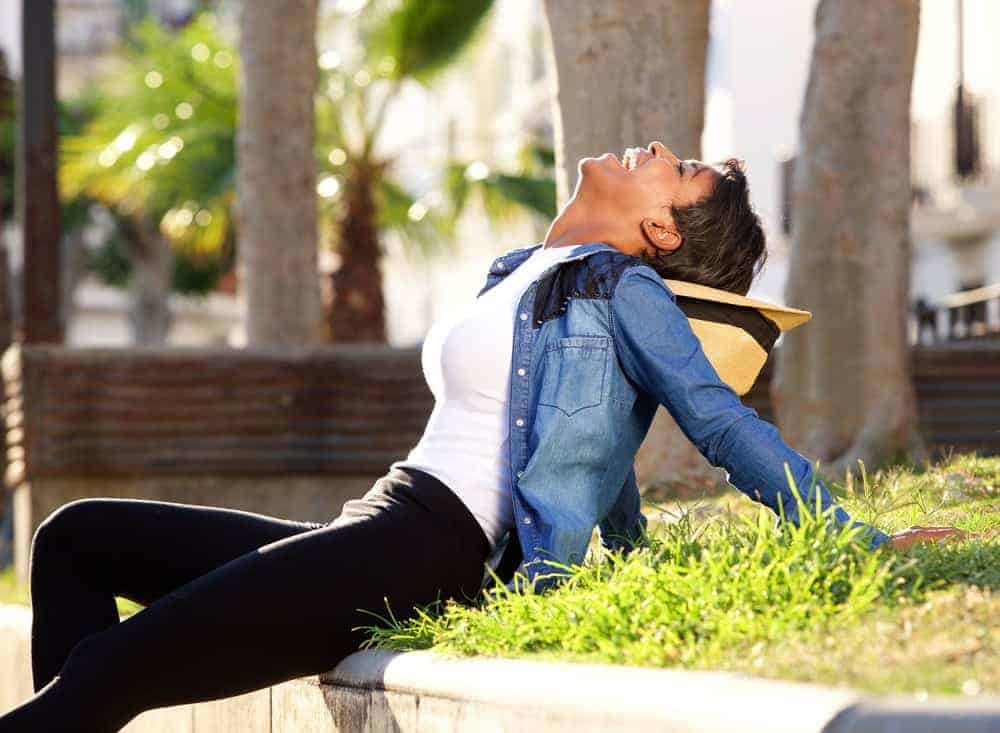
Lye and no-lye relaxers rely on different chemicals during the straightening process.
Relaxers that include lye rely on sodium hydroxide to straighten curly hair. No-lye relaxers, on the other hand, use one of several different chemical compounds including potassium hydroxide, lithium, or guanidine.
Even though manufacturers that make no-lye relaxers often state that they don't include lye or caustic soda, this isn't exactly accurate.
Potassium hydroxide, lithium, and guanidine all fall into the same category of metal hydroxide as sodium hydroxide.
One of the easiest ways to tell whether or not a relaxer contains lye is by the way that it is prepared. No-lye relaxers usually include an extra step where an activator or some other type of component is mixed together with the main relaxer cream.
These formulas that require mixing are some of the best-selling currently available. Keep in mind, however, that not all types of no-lye relaxers require mixing.
There are also no-mix no-lye formulas available that include potassium hydroxide or lithium. Mixing is never required for lye relaxers. Instead, they are applied directly from the tub that they come in without any additional preparation.
Lye relaxers, which contain sodium hydroxide, don't come with an activator.
A Closer Look at No-Lye Relaxers

No-lye relaxers are the preferred choice for people who relax their own hair (i.e., the DIY people).
They also work well for individuals who have sensitive scalps. Children can often use these mild relaxers, as well, as can people who are wanting to achieve straighter results.
A lot of professionals in the industry frown on the use of no-lye relaxers.
There are two basic reasons why:
- Even though no-lye relaxers are less likely to cause scalp damage, they are very damaging to the hair.
- When applied by someone who is not professionally trained, they can cause even more problems.
The Advantages of No-Lye Relaxers
- They are gentler on the scalp. The vast majority of formulas that are sold for sensitive scalps are no-lye relaxers. These formulas are ideal for people who have sensitive scalps or who are looking for a milder option.
- They usually get hair straighter than lye formulas. If you are going for a straighter look, no-lye relaxers are probably the best choice since they tend to do a better job of completely straightening the hair when compared to lye-based relaxers.
- The pH value of no-lye relaxers is usually a lot lower than lye relaxers. As a result, the amount of lifting and swelling experienced by the hair cuticle is typically less significant.
- No-lye relaxers can usually be purchased directly by consumers. They come in kits that include all of the essential supplies that you need including the activator, a neutralizer, a base, and a stick for stirring the product.
The Disadvantages of No-Lye Relaxers
1. After using a no-lye formula, the hair shaft may become coated with mineral deposits. This can give the hair a dull, lifeless look. It can also prevent it from absorbing the moisture that it needs.
Hair that is covered with calcium deposits tends to be brittle and dry. It also breaks more easily. People who use no-lye relaxers often complain about having dry hair.
It is important to note, however, that mineral deposits are not just a problem with no-lye relaxers.
Using hard water on the hair can also result in problems with dryness or dullness. The best way to eliminate mineral deposits on the hair is by using a specially formulated chelating shampoo.
2. Increased disulfide bond breakage. With no-lye relaxers, the breakage of disulfide bonds tends to be a lot greater than with lye relaxers. This is due to their increased ability to straighten their hair.
The straighter the hair becomes, the more disulfide bonds are broken. When straightening is taken to the extreme, it can leave the hair looking limp and lifeless.
3. Overprocessing is a lot more common with no-lye relaxers. People are often conditioned to believe that they need to leave the relaxer on their hair until they experience a tingling sensation.
Oftentimes, this sensation doesn't occur until long after the formula should have been rinsed out with no-lye relaxers. As a result, people wind up leaving the relaxer on far longer than necessary, resulting in overprocessing. This can leave the hair weak and prone to breakage.
4. With no-lye relaxers, the product needs to be used right away. Once the ingredients are mixed, they are usually only good for about a day.
Any cream or product that is left over must be thrown away. The stability of guanidine hydroxide is extremely short-lived. Because of that, the chemicals that are mixed together to create it, which are calcium hydroxide and guanidine, are designed to be mixed directly before use.
When you mix them together, it activates the formula. Once it has been activated, it can only be used for approximately a day before it should be discarded. That is the primary reason why no-lye relaxers are mixed immediately prior to being used.
The Best Way to Use No-Lye Relaxers
It is possible to have beautiful healthy hair even when using no-lye relaxers. The key is to take the following steps to protect your hair.
1. If your hair has previously been relaxed, you can minimize the chances of bond breakage or mineral deposits by coating the hair with a natural oil or conditioner before you begin the relaxing process.
2. Consider chelating the hair when washing out the relaxer. This will help remove any minerals that may have attached themselves to the cuticle. As a result, problems with dryness are far less likely to occur.
Some excellent chelators that you may want to look into include Aloe Rid by Nexxus, Joico Resolve, and Kenra Clarifying Shampoo. By eliminating the buildup that causes post-relaxer dryness, chelating the hair can help keep it soft and can also make it easier to moisturize.
3. Purchase a high-quality product. The quality of no-lye relaxers can vary quite a bit from one brand to another. When choosing a relaxer, opt for a professional brand.
Some great names that you may want to consider include Affirm and Mizani. Along with their professional-grade lye relaxers, these companies also make no-lye formulas.
When choosing a product, look for one that contains either potassium hydroxide or lithium. This will help minimize the chances of mineral deposits building up on your hair.
A Closer Look at Lye Relaxers
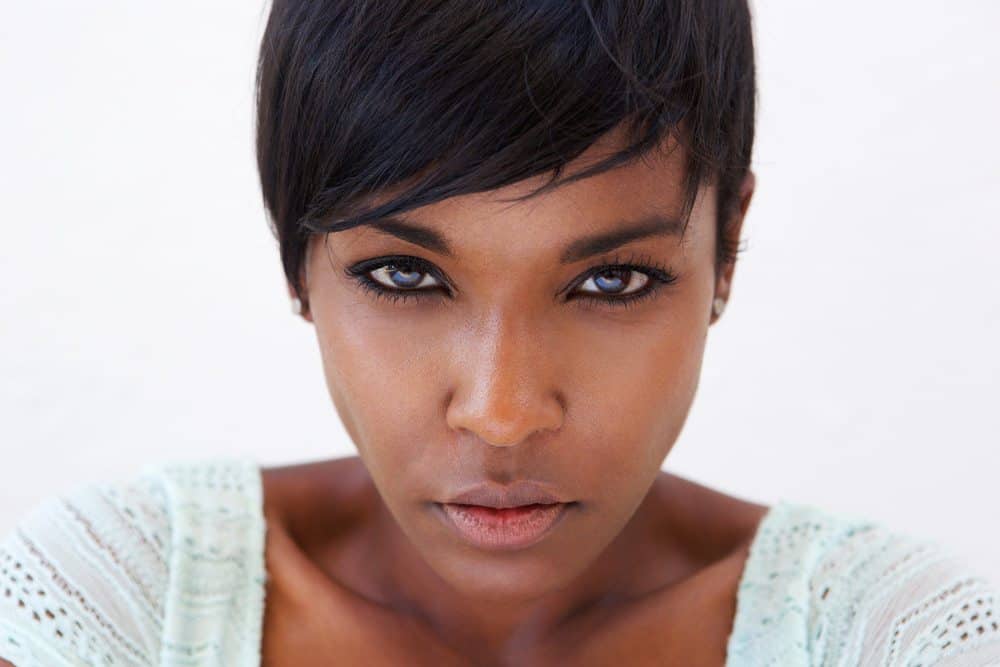
Professional stylists almost always choose lye relaxers for their clients. These relaxers are generally a lot more powerful than no-lye formulas.
While not all stylists agree, most believe that lye relaxers are far superior to no-lye relaxers. Despite that, problems can still occur with lye relaxers if they are incorrectly applied or if the hair is improperly maintained after the relaxing process.
Lye relaxers work well on coarse hair. They are also a good choice for people who don't want their hair quite as straight or for people who would rather have the relaxer applied by a professional at a salon rather than doing it themselves at home.
The Advantages of Lye Relaxers
1. As a general rule of thumb, lye relaxers are gentler on the hair. Unlike no-lye relaxers, they don't cause deposits to build up on the hair shaft.
As a result, it is a lot easier to keep the hair moisturized. Hair that has been treated with a lye relaxer is usually a lot softer and doesn't require additional treatments to restore its silky luster.
2. Reduced breakage of disulfide bonds. The amount of straightening provided by lye relaxers tends to be less than the straightening provided by no-lye relaxers.
As a result, there is a lower level of disulfide bond breakage. This allows the hair to stay strong and makes it easier to maintain its elasticity, reducing the chance of breakage.
3. The processing time is usually lower for lye relaxers. Since these formulas are stronger, they can raise the cuticle layers more quickly. While this results in less processing time, it also requires greater precision and speed to avoid unintentional damage.
4. The increased chemical stability of lye relaxers means that they can be used multiple times and can be stored for a longer amount of time before they need to be discarded. This makes them a good value.
The Disadvantages of Lye Relaxers
1. Lye relaxers have a tendency to be very damaging to the scalp. Due to their high pH level, they can cause a significant amount of damage to the skin on the head.
Many lye relaxers have a pH higher than 13, which can cause them to burn the scalp. Because of this burning sensation, they often can't be left on long enough to adequately straighten the hair, resulting in underprocessing.
2. The amount of hair cuticle swelling is higher with lye relaxers, resulting in more damage to the external portion of the hair fibers. Due to their higher pH level, the amount of time needed to penetrate the shaft of the hair is a lot less.
3. Lye relaxers require less processing time than no-lye relaxers. Unfortunately, this can lead to increased problems with chemical burns or scalp irritation.
4. Lye relaxers usually don't provide as much straightening as no-lye relaxers. This is because the chemicals can't be left on the hair quite as long, and the amount of disulfide bond breakage is decreased.
Disulfide bonds are responsible for creating the curl of the hair, although other important bonds on the outside of the hair are damaged or destroyed by the chemicals in the relaxer.
To improve the straightening results with lye relaxers, always use a base formula. These relaxers tend to be the strongest, which is why they require a petroleum base with full coverage to ensure that the client is properly protected.
5. Lye relaxers usually can't be purchased directly by consumers. Instead, they are designed for professional use. The cost to have your hair straightened with one of these relaxers can range from about $35 all the way up to several hundred dollars.
Essential Tips for Using Hair Relaxers
1. Minimize damage by applying a base to your scalp well in advance of the relaxing process. Adding a heavy petroleum base to your scalp as well as to any sensitive skin that may be exposed to the relaxer can go a long way toward preventing damage.
You should consider applying a petroleum base to your scalp even if you are using a no-base relaxer. Even if you are having your hair straightened by a stylist, you may want to think about basing your scalp yourself before you head to your appointment.
Your stylist may not have time to apply the base thoroughly for you. By doing it yourself, you not only save time but also ensure that your scalp and skin are protected.
2. Apply a protein conditioner directly after rinsing out the relaxer. This will help offset the swelling and lifting of the cuticle. The conditioner should be applied after rinsing out the relaxer but before applying a neutralizing shampoo. You can use this step with no-lye relaxers, as well.
Lye Versus No-Lye Relaxers
Lye and no-lye relaxers each have advantages and disadvantages. While one formula causes less damage to the scalp, the other causes less damage to the hair. Having said that, however, both formulas can still cause hair and scalp damage, which is why they need to be used with extreme caution.
When used incorrectly, they can cause hair loss and chemical burns. Anytime a relaxer comes in contact with your hair or scalp, damage occurs. It is just a matter of controlling the severity of that damage.
Each situation is different when it comes to deciding whether a lye or no-lye formula is best. Problems can occur with any type of relaxer. These problems can range from minor damage to the hair or scalp to severe chemical burns or hair loss.
Whichever option you choose, it is important to follow the instructions closely. When used correctly, both formulas can provide good results. You just need to be aware of all of the potential problems that could arise so that you can take steps to avoid them.
Before using any relaxer on your hair, you need to carefully evaluate the individual product to make sure that it meets your standards and that it will perform well for your specific situation.
The results of your chemically treated hair will not only depend on the product that you choose but also on your hair type, your hair's overall condition, and the application method.
Speaking of No-Lye Relaxers, Does the Coconut Lime Relaxer Work?
Over the last several years, people have been buzzing about ways to naturally relax their hair or loosen their curls. For example, these women are using homemade DIY products, like the coconut lime relaxer.
Coconut Lime Relaxer Recipe
- 2 tablespoon coconut oil
- 1.5 tablespoon coconut cream
- 12 ounces yogurt
- Lime juice (optional)
The recipe is simple. You mix up the coconut oil, coconut cream, and yogurt and cover your hair with the mixture.
Based on what we've seen, this mixture doesn't appear to relax the hair. Furthermore, I'm not convinced that it loosens your natural curls either.
The ingredients in yogurt, namely the bacteria, can break chemical bonds, but I'd want to see a study with a detailed review of the effects on the hair.
Since I don't consider this a real natural relaxer, are there any benefits in our opinion?
Yes, the mixture can be used as a moisturizing treatment. Plus, there are numerous benefits of using coconut oil on your hair. Although, I would probably discard the lime.
What We've Learned About Relaxing Naturally Curly Hair
If the average black woman is asked why she makes the decision to relax her hair, there is one response you are likely to hear over and over again.
Convenience.
However, the convenience that comes with relaxing black hair does have great consequences that come along with it.
By far, hair relaxing is the harshest process that a strand of hair will encounter over the course of its "lifetime." Note that we consider relaxing the hair much more damaging than heat styling with a flat iron.
Relaxed hair, which is compromised from the very beginning, is very challenging to keep in peak condition. Just imagine all of the trauma that is endured by your hair!
Relaxers permanently destroy the unique curl pattern that many of our blog readers have naturally.
Despite all of this, 70-80% of black women relax their hair on a regular basis. We believe that this number is rapidly reducing the emerging natural hair movement.
In this section, we will be providing you with a 9-point checklist of important information and questions that need to be considered before letting your hair be chemically treated by a stylist.
If you decide to have your relaxer administered by a professional stylist, there are some things that you need to look for during your application.
If you notice that any relaxer precautions are being skimped on by your stylist, you have the right, as a paying customer, to bring those issues immediately to her or his attention. After all, it is your hair that is at stake!
Our Checklist: What Things Should You Look out For?
1. Does the stylist thoroughly assess your hair for shedding, breakage, and other types of scalp conditions before the relaxer is applied?
Hair that is breaking or otherwise compromised should never be relaxed! You should always inform your stylist about any medical conditions that you might have that could affect the results of your relaxer.
2. Does the stylist ask about your hair history, including any past chemical treatments that you have had, or ask about what your hair habits are for the previous week before your upcoming relaxer application?
Any good stylist should ask you relevant questions about any past hair treatments that you have had and that might potentially affect the one that you are planning on having.
Make sure to let your stylist know when you last washed your hair, whether your hair is color treated or not, and the date when you had your most recent relaxer application.
3. Before the application, are you shown the relaxer by your stylist that they are going to be using (in its actual relaxer container)?
Always make sure you know which chemicals and strengths are used on your hair! If you end up needing to relocate or switch stylists in the future, your hair maintenance plan will not have to be interrupted.
If you are experiencing a negative reaction to the specific relaxer brand, you will also be able to avoid making the mistake of using it once again later on.
4. Does your stylist use some kind of protective petroleum barrier to protect the ends of your hair that have been previously relaxed?
Always protect your scalp and the ends of your hair before having your relaxer done. Extra attention needs to be given to certain sensitive areas like the length of your hair, edges, the tops of your ears, nape, and hairline so that chemical damage is reduced.
5. Does your stylist just consistently relax new growth, and whenever they are smooth, is the relaxer maintained only on new growth?
It is very damaging to relax hair that has been previously relaxed. Bonds in your hair are destroyed by the relaxer, and the more your hair is exposed to chemical applications over and over again, the more you'll experience an unnecessary breakage of bonds.
Over time, being exposed to relaxer chemicals continuously may degrade the cuticle and could result in overprocessed, breakage-prone, weak, dry hair.
6. Is your hair only relaxed for the amount of time that is required for your specific type of hair?
You should not ever feel the relaxer burner, tingling, or working itself in your scalp in any other way while the relaxer is being applied. Contrary to what is commonly believed, tingling definitely doesn't mean a relaxer is working.
What it does mean is that the relaxer has breached the protective layers and your base, and your scalp and hair are vulnerable to damage now. If you feel any tingle, you have waited too long to start rinsing.
It's also important to note that neutralizing shampoos work great to get the relaxer process stopped; however, they have to be given enough time to work!
If the neutralizer is rinsed out of the hair before giving it a chance to penetrate into the hair shaft and stop the chemical reactions within the hair that can result in hair that is over-processed, dry, and weak.
Before starting to rinse, your stylist should allow the neutralizer to remain on your hair for 3 to 5 minutes at least.
7. Was post-relaxer upkeep explained to you by your stylist?
A good stylist will educate their clients on healthy hair care basics like moisturizing conditioning treatments and protein. Healthy hair care occurs at home in between visiting the stylist.
It starts with you.
Having a good stylist can help you make sure that a healthy head of hair is maintained and will not be afraid of sharing her or his knowledge with you? Why is that?
Because if they do they know it is likely you will be coming back to see them again!
8. Are you encouraged by your stylist to limit the use of chemicals by stretching out your relaxer applications so that they occur no sooner than 8-10 weeks apart to maintain a healthier scalp and head of hair?
For best results, relaxer application should only be done every 8-10 weeks or longer. When hair is relaxed too often it can weaken the hair and it becomes susceptible to damage and breakage. Give your scalp and hair the chance to recuperate and rest in between relaxer applications.
9. Does the stylist respect your time, your hair, and your other concerns and needs?
By far this is one of the most critical questions that need to be asked. If you are not able to communicate well with your stylist, it could spell disaster.
Any hair concerns that you have should always be shared with your stylist. If there is a specific relaxer brand that you don't like, ask your stylist to try something new.
Let her know if you would like your hair processed for shorter amounts of time. If you are finished with relaxers and are thinking about transitioning from relaxed hair to natural hair, then you should be supported by your stylist.
If your answer to any of the above questions was "no," you should consider getting a different stylist. Over time, mistakes like those that were discussed above could devastate the health of your hair and progress.
Because hair is non-living, whatever damage is caused to it is irreparable and cumulative. So the next time you are preparing for a chemical relaxer service, remind yourself of the above questions.
Are you getting the royal treatment? Don't just sit back idly and let someone sabotage the success of your hair, especially when you paying them to do it!
Creamy Crack: Why You Shouldn't Relax Your Hair
When people are addicted to controlled substances, they often seek professional help. They join a drug treatment program designed to rid the body of toxins and increase the chances of long-term sobriety.
Within this program, they discuss how confident they feel when they take the drug. This confidence is often because the drug alters the mind, giving you more confidence to cope with the problems of everyday life.
On the other hand, the addict also acknowledges the devastating impact that the controlled substance has had on their life – including the impact on family and friends.
Without these treatment programs, it would be much more difficult for some people to stop using these controlled substances.
So, how do you cope when there is no professional help and no true diagnosis for your substance abuse?
You may be thinking that there is professional help for all types of substance abuse. Let’s explore whether that’s entirely true.
What Happens When You Are Addicted to Creamy Crack?
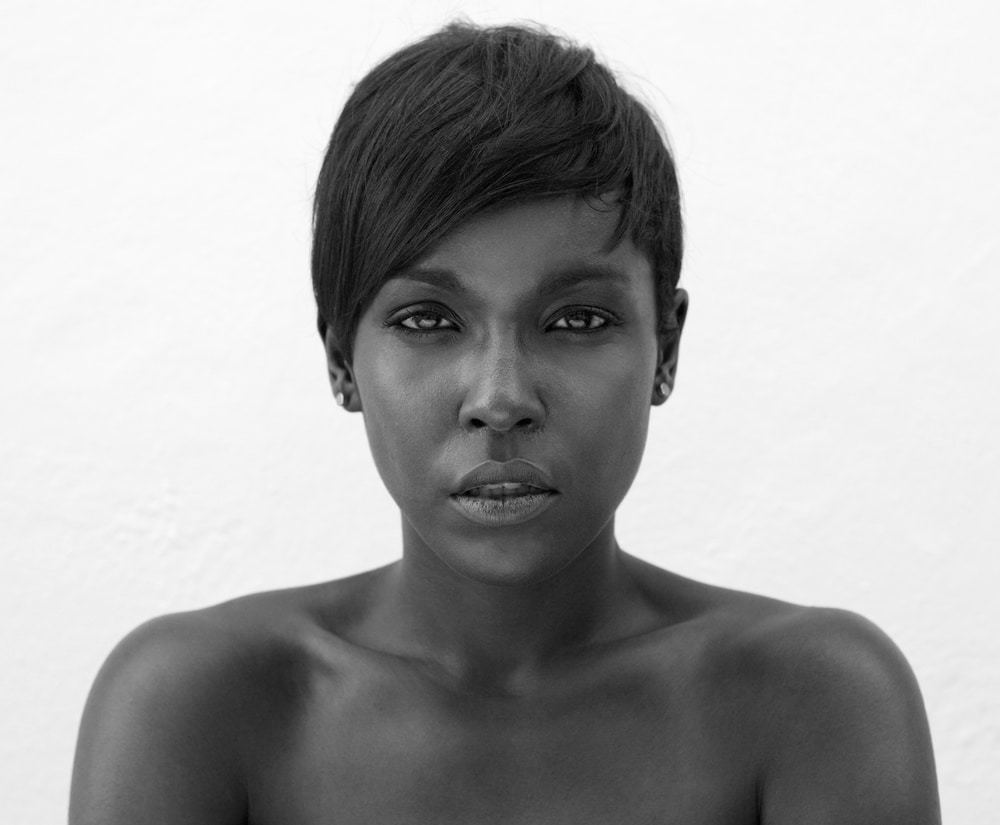
The term creamy crack, which defines a relaxer as crack, is a term of endearment for some and used negatively by others. Hence, the correlation to having a drug addiction.
When the problem begins to show its ugly head, you may feel the need to communicate with someone.
The person that people often talk to initially is their hair stylist. Be careful during this conversation, because this person is actually your pusher (drug supplier).
This is analogous to having a discussion with a pusher, explaining to them that you no longer want their product or services. Usually, that conversation doesn't go very well.
It's rare that a stylist will actually give you their blessing to stop relaxing your hair.
You’re a client that has decided to leave them, and they often will say whatever it takes to make you stay – including ridiculous things like your hair is too nappy and needs creamy crack because it would be totally unmanageable without a relaxer.
Don't listen to this nonsense.
These types of conversations are really just a form of peer pressure.
Women are being pressured by certain social groups and media outlets to strive for a specific level of beauty in hair and body type, and if you don’t fit within those parameters then you are not beautiful according to their standards.
If women know that relaxers are bad for them, then why do they continue to relax their hair?
Maybe they relax their hair out of habit and fear of the unknown, but most keep doing it for one simple reason: they are addicted to relaxers and the effect that relaxers have on their hair.
After your hair has been relaxed you are on a high. You have achieved the desired straightness that you wanted and you feel complete.
This euphoria comes from having the relaxer and it provides you with a new level of confidence. The painfully burning, scabs, and balding spots – which are warning signs of a much bigger problem – are ignored.
A common thread that I’ve noticed is that women who were around women that had relaxed hair, especially at an early age, have a higher propensity to relax their hair and their daughter’s hair – if applicable.
It's really amazing that some women have been relaxing their hair for decades through the chemical burns, balding spots, and other mishaps, yet are still dead set against giving the relaxer up.
- Relaxers for Caucasian Hair
- Products That Make Relaxed Hair Curly
- What Does a Perm Do to Your Hair?
- What Causes a Perm Not to Take?
So where would one go for rehab?
Curl Centric provides rehab for naturals who want to stop the relaxer high. The rehab really begins with you making the decision not to relax anymore.
Next, you must surround yourself with people who are able to look past your hair, encourage you, and celebrate your real hair and the real you.
These are the first steps to your mental transition and to beginning your natural hair journey.
Will it work the very first time?
It may not.
It took two rounds of going natural for me within 10 years before I stuck with it. Now, I’m not looking back.


